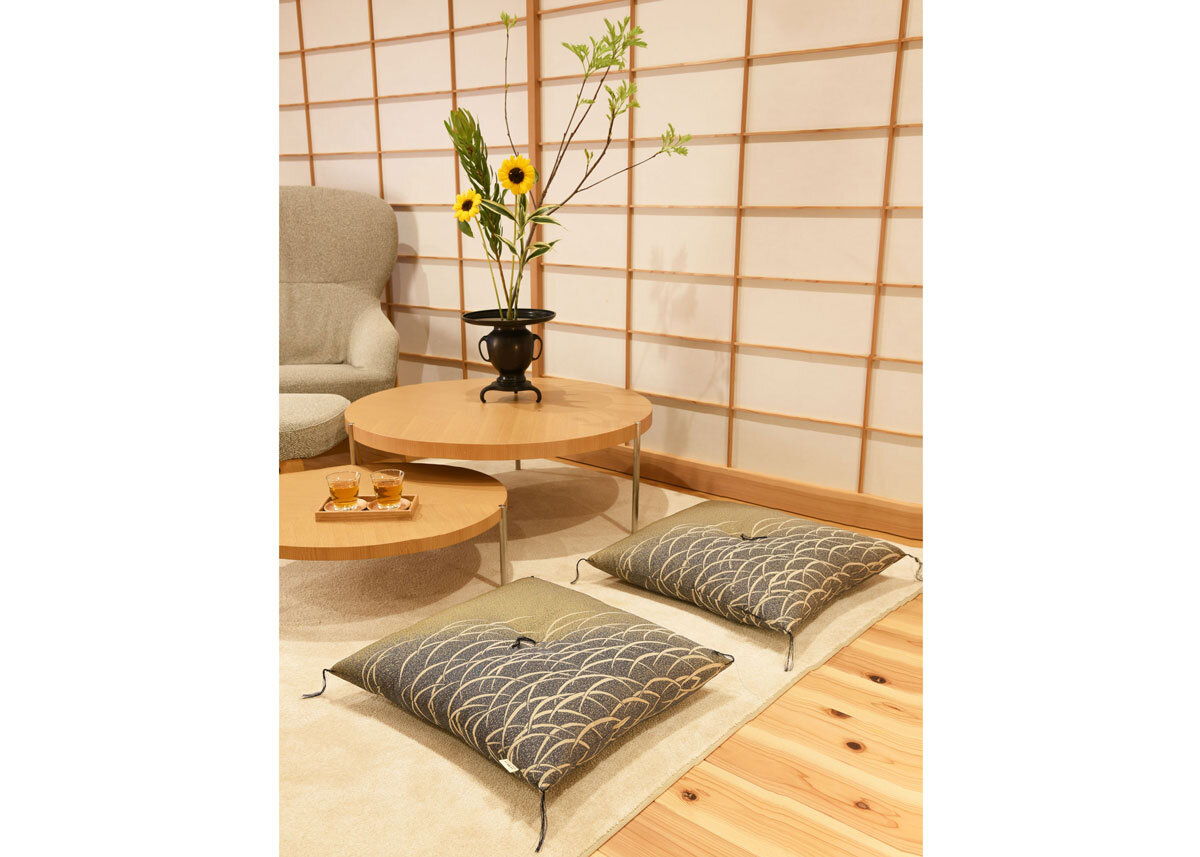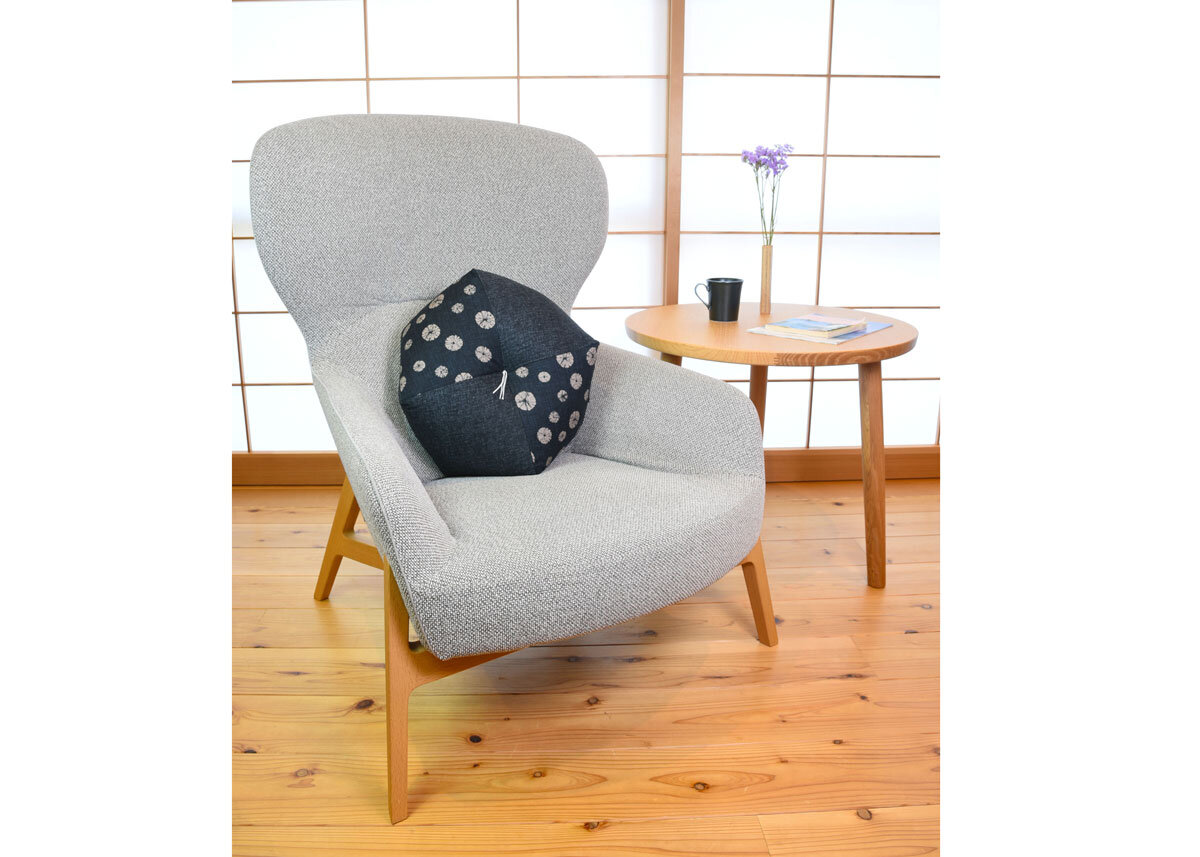Japan Zabuton Floor Cushions available at Japan Objects Store
Zabuton are rectangular cushions, sort of like miniature futons, that make sitting or kneeling on the floor for long periods of time far more comfortable. With almost a thousand years of history behind them, zabuton hold a special place within Japanese culture.
Once enjoyed only by people in high-status positions like the imperial court, or esteemed Buddhist monks, zabuton are now an essential part of daily life in Japan. They have also become a necessary part of prolonged meditation, and historically have significance within the biggest sumo matches. Find out everything you need to know about Japanese zabuton cushions, what you can use them for, and where to get them!
1. What are Zabuton?
2. What Does Zabuton Mean?
3. The History of Zabuton
4. What Are Zabuton Used For?
5. How to Sit on the Floor with Zabuton?
6. Can I Use my Zabuton as a Seat/Sofa Cushion?
7. Can I Use Zabuton for Yoga or Meditation?
8. Can I Use a Zabuton as a Pillow?
9. Are Zabuton Safe for Babies?
10. What are Some Other Practical Ways to Use Zabuton?
11. Where are Zabuton Made?
12. How Are Zabuton Cushions Made?
13. What are Zabuton Made Of?
14. What Size and Shape are Zabuton?
15. Why Do Some Zabuton have Tassels?
16. What Does the Symbol in the Middle of the Zabuton Mean?
17. Is it Best to Have a Firm or Soft Zabuton?
18. How Do I Take Care of My Zabuton?
19. What Japanese Home Decor Items Go Well with Zabuton?
20. Where to Buy Zabuton?
1. What are Zabuton?
Matcha Green Zabuton Cushion, available at Japan Objects Store
If you have spent any time in Japan, particularly in ryokans, Japanese restaurants or hot spring resorts, you’ll have encountered these beautiful floor cushions in one of many designs and sizes.
They are almost always a rectangular shape with a gently rounded top; the center of the cushions bears the weight, helping with posture and they will usually be finished at the corners with tassels. Zabuton are meant to contain your body heat meaning you will be much warmer than if you simply sat on a tatami floor. It is considered bad etiquette to step on a zabuton and can be insulting if you are a guest, so a graceful approach to standing and sitting is encouraged in this case!
2. What Does Zabuton Mean?
Tsuyukusa Gold Zabuton Cushion, available at Japan Objects Store
Zabuton is written in Japanese using the characters for sit (座 za) and futon (布団), a thick floor mattress. Essentially, a zabuton is a futon reserved for sitting! If you’re not familiar with futon, find out Everything You Need to Know About Japanese Mattresses.
3. The History of Zabuton
Summer Kimono Bijin by Torii Kotondo, Mid 20th Century
Closely linked to the tatami mat which, at one point, indicated a person’s wealth and authority, zabuton started as small square rugs placed on the tatami to sit on. It was during the Edo period of the 17th to 19th centuries, that tailors started to fill them with cotton padding for comfort and created the more familiar, and luxurious, cushions we use today. They’re certainly not as easy to make as it first appears, what gives the zabuton its firmness and stability is the unique manufacturing process.
The traditional way to sit on zabuton is in the seiza style where you kneel, legs tucked underneath you, with the tops of your foot resting on the floor, but they are also used cross-legged. Here are 3 Comfortable Ways to Sit on the Floor.
4. What Are Zabuton Used For?
Japan Zabuton Floor Cushions available at Japan Objects Store
The cushioning and support of a zabuton reduces pressure on the legs and knees, allowing one to sit comfortably for an extended period of time. As such, Zabuton are especially useful during mediation sessions and religious ceremonies conducted by Buddhist monks and Shinto priests.
While zabuton are primarily used for sitting, they have a dynamic and colorful history. At sumo matches, spectators once threw items at wrestlers in a passionate display to congratulate (or jeer) victors, often grabbing the closest object next to them, a zabuton! The practice was banned in the early 20th century; However, zabuton are now tied down in order to deter would-be cushion throwers!
5. How to Sit on the Floor Using Zabuton
The use of a zabuton while sitting in seiza style (a kneeling position in which the soles of both feet rest on the floor) protects the skin and joints of the knees, feet, and ankles. Alternatively, you may sit cross-legged on a zabuton.
Whether sitting in the formal seiza position, or lounging more comfortably, check out the video above for a guide on how to sit on the floor on a zabuton.
6. Can I Use my Zabuton as a Seat/Sofa Cushion?
Shibori Black Zabuton Cushion, available at Japan Objects Store
Although zabuton were originally designed for use on the floor, they also make great seat cushions, and brighten up a room. A plush zabuton cushion can transform any uncomfortable chair into a cosy, pleasurable, and ergonomic experience!
7. Can I Use Zabuton for Yoga or Meditation?
Kyoto Red Zabuton Cushion, available at Japan Objects Store
Zabuton have long been used by monks, spiritual teachers and practitioners of mindfulness. As such, they are an excellent tool that will provide physical support during yoga practice or meditation sessions. The flat bottom and rounded top shape of a zabuton aligns the spine, creating the ideal posture and stability necessary to comfortably meditate for long periods of time.
You will also find that many people who meditate prefer a zabuton with a zafu (a rounded type of cushion) on top to further benefit posture and longevity. For this reason, we highly recommend incorporating a rounded ojami zabuton cushion into your practice.
Likewise, yoga practitioners will surely appreciate the support that zabuton can provide when placed under the head, neck, hips, knees, and back. When sitting on a zabuton, the hips are angled and the spine is tall and alert. Zabuton also tilt the hips forward, allowing the body to fold a bit more easily and to safely deepen twisting positions.
8. Can I Use a Zabuton as a Pillow?
Kyoto Red Ojami Zabuton Cushion, available at Japan Objects Store
Certainly! When used as a floor or seat cushion, zabuton provide hip, ankle. and knee support. Likewise, zabuton can be used to support the joints while sleeping. Use a zabuton like the ojami cushion as a leg elevation pillow to improve blood flow to the lower extremities, thereby preventing swelling, pain, and blood clots.
9. Are Zabuton Safe for Babies?
Tsuyukusa Gold Zabuton Cushion, available at Japan Objects Store
When used as an alternative to a playpen, zabuton provide a safe and comfortable space for infants to explore and play. Aside from a play mattress, they can also be used for naptime or as a changing table. However, infants should not be left unattended when on a zabuton in order to reduce the risk of suffocation.
10. What are Some Other Practical Ways to Use Zabuton?
Seigaiha Blue Ojami Zabuton Cushion, available at Japan Objects Store
One often overlooked function of a zabuton is its use as an ergonomic cushion, particularly the ojami series. The handcrafted layers of a zabuton reduces the stress on the ligaments and joints and supports and corrects posture. It can also be used as a neck support or to elevate the lower limbs when resting, helping you stay relaxed longer and more comfortably.
11. Where are Zabuton Made?
© Takaokaya, Making Zabuton Cushion
These days you can find zabuton manufactured in factories all over the world. However, if you want the best quality, opt for a zabuton made in Kyoto, Japan, which is where all of the zabuton in the Japan Objects Store are made.
Masterful brands like Takaokaya combine the rich history of Kyoto’s textile industry and the Japanese concept of kutsurogi (a state of complete relaxation) to produce ultimate comfortability.
12. How Are Zabuton Cushions Made?
© Takaokaya, Making Zabuton Cushion
Zabuton are created by layering and folding cotton repeatedly until you have the perfect shape. Although this is a simple premise the process is complex and requires skill and patience to create a comfortable cushion. The cover will normally be made of cotton, linen or silk and you will notice some interesting recognizable traits on each zabuton.
For example, if you find a zabuton cushion in the city of Kyoto, you will discover a sampo-toji, or three-pronged stitch, in the center, which shows the sitter which way the cushion should lie. On high quality zabuton cushions you will also find tassels on the four corners, which represent good luck.
The best zabuton floor cushions are entirely handmade and the quality difference is immediately evident. From cutting the initial cotton to sewing, stuffing, and finishing - hours of labour and passion go into each cushion. The challenge for craftsmen of zabuton is to make sure the padding is firm and even throughout the layering process otherwise lumps can occur or they just don’t provide the same benefits for your body.
Masterful brands like Takaokaya, based in the ancient capital of Kyoto and available at Japan Objects Store have been key in making the zabuton available for the contemporary Japanese home. With skills passed down the generations, they hand make and design all of their products and have been creating pure cotton zabuton and futon bedding for one hundred years. You can even visit their workshop to see them in action!
Zabuton are a perfect example of how traditional Japanese design and culture can be enjoyed functionally as part of a modern lifestyle.
For some other ways to incorporate Japanese design into your life, check out our guides to Hanten Jackets, and Furoshiki Wrapping Cloth!
13. What are Zabuton Made Of?
© Takaokaya, Zabuton Cushion Padding
The best zabuton cushions are made of natural fibres, such as cotton, linen or silk. The interior padding is also made of predominantly cotton. However, these days it is common to include a small percentage of polyester threads in the cotton padding. This helps the zabuton to keep its shape, and natural bounciness, even after prolonged use.
14. What Size and Shape are Zabuton?
Shibori Black Zabuton Cushion, available at Japan Objects Store
The reason for the rectangular shape of the traditional zabuton cushion, is that they are designed to be knelt on, and when you do so, you create a shape that is longer than it is wide.
If you go to a temple in Japan you’ll see quite large zabuton, generally about 23” x 25” (59cm x 63xm). This was the traditional size, especially when luxurious cushions were restricted to larger houses and institutions. These days however, most Japanese households use a more manageable size of 21 ½” x 23” (55cm x 59cm), which is still more than big enough for all body types.
© Takaokaya, Making Zabuton Cushion
Of course zabuton aren’t restricted to one particular style, they can be any style you can imagine. One particularly useful design is the Ojami Zabuton, inspired by the Japanese bean bag toy filled with azuki beans. Much thicker and firmer than a standard Japanese cushion, they are absurdly comfortable and give great support. They’re particularly useful if sitting on a flat surface is difficult, as they raise the hips above the legs. Ideal for meditation!
15. Why Do Some Zabuton have Tassels?
Matcha Green Zabuton Cushion, available at Japan Objects Store
High-quality zabuton cushions, particular those made by traditional artisans, or found in settings like temples, will always have tassels on each corner. These were originally included to prevent harmful energy from disturbing one’s state of mindfulness. And of course, they look great!
16. What Does the Symbol in the Middle of the Zabuton Mean?
Tsuyukusa Gold Zabuton Cushion, available at Japan Objects Store
If you purchase a zabuton made in Kyoto you may notice the Y-shaped stitch in the middle. Known as a sampo-toji, this design feature has the useful benefit of helping to orientate the cushion: the bottom of the Y should be pointing forwards.
17. Is it Best to Have a Firm or Soft Zabuton?
Ojami Zabuton Cushions available at Japan Objects Store
Zabuton padding is carefully layered to offer the benefits of ergonomic seating, such as posture support and correction. The center of the cushions bears the body weight; therefore, the best zabuton have firm padding.
18. How Do I Take Care of My Zabuton?
Shibori Black Ojami Zabuton Cushion, available at Japan Objects Store
Zabuton are pretty dense cushions, so machine washing or submerging them in water could damage the padding. In order to remove stains, use a damp cloth immediately to spot clean.
Shake out your zabuton regularly to remove dust and air them out frequently for a few hours in a sunny location. Make sure to cover them with a thing cloth though to avoid the colors fading in the sun.
19. What Japanese Home Decor Items Go Well with Zabuton?
Japan Zabuton Floor Cushions available at Japan Objects Store
Zabuton are a perfect example of how traditional Japanese design and culture can be enjoyed functionally as part of a modern lifestyle.
If you feel reluctant to incorporate floor cushions into a home that doesn’t have tatami mats, remember that zabuton remain very popular in Japanese homes, even while many houses and apartments no longer use tatami.
Floor cushions create an inviting space when paired with low coffee tables. This is especially true during the winter months when families gather around a heated kotatsu table with plenty of snacks and freshly brewed tea in hand! Pull up your zabuton next to the kotatsu and feel the warmth as you wrap yourself in a thickly padded hanten housecoat paired with our cotton samue loungewear.
Japanese Futon Mattress, available at Japan Objects Store
If you're looking to transform a studio apartment, zabuton are one of many traditional Japanese furnishings that function as multi-purpose furniture. Zabuton, like futon bedding, can be put away behind a shoji screen divider when not in use, freeing up valuable space in your room. Alternatively, if you have a low tansu storage chest, you may place your zabuton on top of it to create a bench with storage space!
20. Where to Buy Zabuton?
Matcha Green Zabuton Cushion, available at Japan Objects Store
Picking your perfect zabuton or putting together a collection has never been easier with the diverse range of products lovingly made by hand by Takaokaya, and available at Japan Objects Store with free shipping worldwide! Kyoto zabuton craftsmen use their finely honed skills that have been passed down with pride for generations, to make superbly comfortable and high-quality cushions. Founded by Tokutaro Takaoka in 1919, they initially manufactured futons for Kyoto’s department store Daimaru before creating the home furnishing brand Takaokaya to offer kutsurogi (the Japanese art of relaxation) to every kind of lifestyle by creating a wide range of kangu (relaxing products) to bring a ‘smile to everyone’s face’.
The zabuton cushion collection at Japan Objects Store features traditional Japanese patterns, of both the traditional Kyoto Zabuton rectangular shapes, as well as the more contemporary round and two-tone seat and meditation cushions.
Whatever you choose, you can be sure of the exquisite quality and craftsmanship that comes with one of the most esteemed zabuton brands in Japan.
Some favorites include:
Shibori Black Zabuton Cushion, available at Japan Objects Store
Whether you’re looking to decorate your home, or trying to find an authentic Japanese meditation cushion, then Takaokaya’s range of traditional colors and designs are true to the traditions of hundreds of years of zabuton craftsmanship.
The Shibori Zabuton for instance, is fashioned after the traditional shibori tye-dye art form originating around 1300 years ago. The style of dyeing is quite unique as it involves twisting, folding and binding cloth before dyeing it indigo. The binding will resist the ink so creating bold patterns resembling flowers, diamonds, or dots. To learn more about Shibori, check out 5 Things You Should Know About Japanese Shibori Dyeing.
Kyoto Red Ojami Zabuton Cushion, available at Japan Objects Store
The round Ojami zabuton makes an ideal meditation cushion. It is thicker and firmer than most zabuton cushions so provides support whether you’re sitting on the floor, on a hard chair, or a luxurious sofa.
This iconic pattern of these cushions represents the fan-shaped waves of the open sea which come together to form a repeated pattern. It's a symbol for good luck and peaceful living, like the relaxed waves. The name comes from the ancient dance Seigaiha which also features in a scene in The Tale of Genji.















ART | October 6, 2023